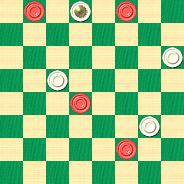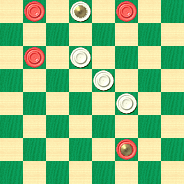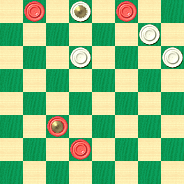The Checker Maven
Jump to navigationThree Bridges

Judging by the photo above, the train is about to pull in to Three Bridges Station, and if we want to get to Chichester, we'd better get on board.
Today's entry in our Checker School series is also about three bridges, and about getting on board with their solutions if we want to ride the train to checker success. The three related bridge positions shown below are taken from Ben Boland's Famous Positions in the Game of Checkers, and knowing how to handle this very common ending type is vitally necessary, as bridge positions arise all the time in practical play. The settings are attributed to old-time players Thirkell, Keenan, and McHardy.
BLACK

WHITE
White to Play and Draw
W:WK2,12,14,24:B1,3,18,27.
J. G. KEENAN
BLACK

WHITE
Black Plays, White Draws
B:WK2,10,15,19:B1,3,9,K27.
A. McHARDY
BLACK

WHITE
White to Play and Draw
W:WK2,8,10,12:B1,3,K22,26.
Bridge positions can be tough to defend, and the ones above require both care and technique. Can you bridge the gap and find the drawing moves? Work out the answers and then move your mouse across the bridge to Read More to see the solutions, sample games, and detailed notes.![]()
Solutions
Editor's Note: Many variations are possible in these solutions; use your computer to explore further.
Thirkell: 24-20, 27-31, 20-16, 31-26, 16-11, 26-22, 11-8, 18-23, 8-4, 23-26, 4-8, 22-18, 14-10, 18-22, 2-6, 22-17, 6-9, 17-13, 9-14, 26-31, 8-11, 31-27, 11-16, 27-23, 16-11, 23-19---J, 11-15, 19-16, 14-18---K, 1. Drawn.
Keenan: 27-23---L, 19-16*, 23-18---M, 15-11, 9-13---2, 16-12, 13-17, 11-8, 17-21, 8-4, 18-22---N, 4-8, 21-25---O, 2-6, 22-17---P, 6-9, 17-13, 9-14, 25-30, 8-11, 30-26, 11-15, 26-23, 15-11, 23-19, 11-15, 19-16, 12-8, 3-12, 10-7---3. Drawn.
McHardy: 2-6---R, 22-17---S, 6-9, 17-13, 9-14, 26-31---T, 8-4, 31-26, 4-8, 26-23---U, 8-11, 23-19---V, 11-15, 19-16, 12-8, 3-12, 10-7, 16-20, 15-19, 1-6, 7-3, 20-16, 19-15---4. Drawn.
Game: 10-14, 23-18---A, 14-23, 26-19---B, 9-14---C, 27-23, 11-16, 24-20, 6-10, 20-11, 8-24, 28-19, 7-11, 22-18, 4-8, 18-9, 5-14, 30-26---I, 11-15, 19-16, 12-19, 23-16, 15-19, 25-22, 2-7, 16-12, 10-15, 21-17---D, 14-21, 29-25, 21-30, 31-27, 30-23, 27-2, 8-11, 32-27---E, 11-15---F, 22-17---G, 15-18, 17-14, 19-23, 27-24, 23-27---H. Forms above position by P. Thirkell. Game 68, Var. 1, J. M'Dowall vs. A. B. Scott, Glasgow Tournament Games, 1909.
Game: 9-13, 21-17, 5-9, 25-21, 9-14, 24-19, 11-15, 30-25, 15-24, 28-19, 7-11, 22-18, 13-22, 18-9, 6-13, 26-17, 13-22, 25-18, 11-15, 18-11, 8-24, 27-20, 10-15, 29-25, 15-19, 23-16, 12-19, 25-22, 19-23, 22-18, 4-8, 20-16, 2-7, 16-12, 8-11, 21-17, 7-10, 18-14, 10-15, 14-10, 15-18, 17-14---B1, 11-15, 14-9, 23-26, 31-22, 18-25, 9-6, 15-18, 6-2, 18-22, 32-27, 25-30, 27-23, 30-26, 23-18, 26-23, 18-15, 23-18, 15-11, 22-26, 11-8---C1, 18-22---Z. Forms above position by A. McHardy. Master Play, Part I, Var. O, by W. I. Wray.
A---Exceptionally weak for White, and may be classified with the 12-16, 23-19 opening. Master Play, says, "An even barred opening."
B---In the Ferrie-Wyllie contest the former took the piece this way, but Wyllie varied with 27-18, both games ending in draws.
C---Wyllie played 6-10 at this point.
D---In Game 68 Scott played: 22-17, 14-18, 32-27, 8-11, 17-14, 11-16, 21-17, 16-20, 14-9, 19-24, 26-22, 18-25, 29-22, 24-28, 27-23, 28-32, 23-18, 15-19, 18-15, 19-23. Black Wins---M'Dowall.
E---22-18 might give more fight, but Black still seems strong.
F---11-16 would allow a draw.
G---12-8, 3-12, 2-7, 12-16, 7-10, 16-20, 23-19, 1-5, etc. Black Wins.
H---Left here with this note: "Leaving Black a powerful finish." P. Thirkell then showed above continuation in the Draughts World, Nov. 1910, Vol. 36.
I---Master Play shows this up to 10-15 as a Black Win by ]. Lees; 25-22, 11-15, 32-27, 15-24, 27-20, 10-15, 22-18, 15-22, 30-26, 2-6, 26-10, 6-15, 31-27, 15-19, 23-16, 12-19, 20-16, 8-12, 21-17. Drawn. J. Owens vs. G. Jewitt.
J---This is now No. 891 by W. }. Hastings, at 14th move of solution, the Draughts Review, July 1928, Vol. 4, from Chicago Daily News.
K---The shorter method of drawing, as shown by Keenan and McHardy, is 12-8, 3-12, 10-7. This, however, is not new, it may be found in Souter Game 154, F. W. Drinkwater vs. W. Bell (played at Cardiff, England), American Checker Player (Phelan's), June 1876. Thirkell continued; 13-9, 18-23, 9-6, 23-27, 6-2, 27-23, 16-20, 23-19, 2-6, 19-23, 20-24, 23-19, 24-28, 19-23, 28-32, etc. Drawn.
L---27-24, 10-7. Drawn.
M---23-19, 2-6, 19-12, 6-13, 12-16, 13-9, 16-19, 9-5*. Drawn.
N---21-25, 4-8, 25-30, 2-6, 30-25, 6-9, 25-21, 8-11, 21-17, 10-6, 1-10, 9-6, 10-15, 6-10. Drawn.
O---22-17 8-11, 17-13---Q, 11-15, 13-9, 15-18, 21-25, 10-7, 3-10, 2-7, 10-14, 18-22, 25-30, 7-10. Drawn.
P---25-30, 8-11, 30-25, 6-9, 25-21, 11-7, 21-25, 7-11, 25-30, 11-7, 30-26, 7-11, 26-23, 11-7, 23-19, 7-11, 22-18; 10-6, 1-10, 9-6, 19-15, 11-7, 18-14, 7-2. Drawn.
Q---21-25, 11-15, 25-30, 15-18, 17-13, 10-6, 1-10, 2-6. Drawn.
R---Corrects Problem No. 1037 in Gould's Problem Book, and Var. O, in Tescheleit's Edinburgh, where 8-4 allows a Black Win; 8-4, 22-17, 4-8, 26-30, 8-11---W, 30-25, 11-8, 17-13, 2-6, 25-22, 8-11, 22-18, 11-16, 18-15, 16-20, 15-11, 6-2, 13-9, 20-24, 11-15, 24-20. Black Wins. W. J. Wray.
S---22-18, 8-4, 26-31, 4-8, 31-26---X, 6-9, 26-22, 8-11, 22-17, 10-6, 1-10, 9-6, 10-15, 6-10, 15-19, 10-19, 3-7, 15-13, Drawn.
T---26-30, 8-4, 30-25, 4-8, 25-21, 8-M, 1.5, 11-7, 13-9, 14-18, 21-17, 7-2. Drawn
U---26-22, 8-11, 1-5, 14-17, 22-18, 17-21, 13-9, 21-25, 18-14, 11-7. Drawn.
V---1-5, 11-7. Draws.
W---2-6, 30-25, 6-9, 17-13, 9-6, 25-22, 8-11, 22-18, 11-7, 18-14. Black Wins. W. J Wray.
X---31-27, 6-9, 27-24, 8-11, 24-20---Y, 9-13, 18-23, 13-9, 23-19, 10-6, 1-10, 11-15, 10-14, 15-24. Drawn.
Y---24-19, 10-6 (9-6 also draws), 1-10, 9-6, 19-15, 11-7, 18-14, 7-2, 14-17, 2-7, 10-14, 6-9, 3-10, 9-11. Drawn.
Z---26-31, 8-4, 31-27, 4-8, 27-24, 2-6*---A1, 18-22, 6-9, 24-19, 8-11, 22-18, 11-8 19-16, 9-6, 16-19, 8-11, 19-23, 11-7, 23-26, 7-11, 26-30, 11-7, 30-25, 9-13 25-21, 7-11, 22-18, 11-7, 18-23, 7-11. Drawn. F. Tescheleit, 1928.
A1---8-11, 24-20, 11-8, 18-22, 8-11, 22-17, 11-8, 17-13, 8-11, 13-9, 11-7, 9-14, 2-6, 14-18, 6-2, 18-15. Black Wins. F. Tescheleit, G. W. Herald, 1903.
B1---10-7, 3-10, 12-8, 10-15, 8-3, 11-16, 3-7, 23-26, 31-22, 18-25, 7-11, 15-18. Drawn. R. Stewart and H. F. Shearer.
C1---Forms No. 1037 by W. J. Wray, in Gould's Problem Book. Also W. J Hastings. See Note J.
1---The White man on 10 is safe in all scenarios. Try it on your computer---Ed.
2---18-15 2-6 drawn---Ed.
3---White gets a fascinating man-down draw: 1-5 7-2 16-20 2-6 12-16 15-18 20-24 18-23 24-28 6-10 16-20 10-6 20-24 14-18 28-32 6-10 24-27 18-22 27-31 10-14 and now the White king on 14 holds the Black pieces on 13 and 5 while the other White kings hold the other Black kings at bay.
4---A different man-down draw: there is nothing here other than repetition of 16-20 15-19 20-16 19-15.
P. Thirkell Position may be found in the Draughts World, Page 87. Nov 1910, Vol. 36.
J. G. Keenan's Position is No. 230 in the Draughts Review, Dec. 1925, Vol 1. This position is sometimes called "Keenan's Drawbridge."
A. McHardy's Position is No. 10 in the Appendix to McHardy's Relative Positions. It is a correction of W. J. Wray, see Notes CI, and R. McHardy first published his position in the Los Angeles Times, January 1927. Also se< Note K.
This ending may arise in play in many different ways, just as "Petterson's Drawbridge," or as any standard end game does.
You can email the Webmaster with comments on this article.
